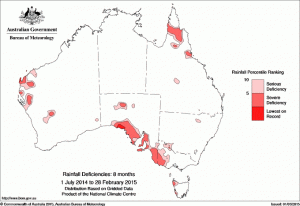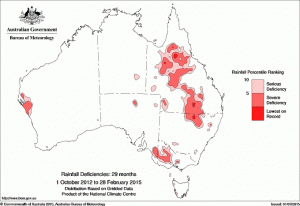After a wetter than expected start to 2015, the tap largely turned off during February, with national rainfall for the month falling to half the long-term average for many areas.
The Bureau of Meteorology’s latest national drought report shows that despite the recent December/January rain, long-term drought conditions remain a stark reality for many.
Rainfall during February was below average for many areas including the Kimberley and adjacent parts of inland Western Australia, most of the Northern Territory, most of inland Queensland, north eastern new South Wales, much of South Australia and adjacent border regions of NSW and Victoria, and most of Tasmania.
As the map shows, over the past eight months some areas received totals in their lowest 5-10pc of records including parts of southern South Australia, western Victoria, southern New South Wales and along the west coast of Tasmania.
Taking a 29 month perspective (October 2012 to February 2015), rainfall deficiencies have increased across central northern Queensland south of the Cape York Peninsula, extending through inland southern Queensland to northern New South Wales inland of the Great Dividing Range, and in the area covering western Victoria and adjacent southeastern South Australia.
Severe and serious deficiencies are in place across these areas as well as in small areas of southwestern Queensland and adjacent parts of the southeastern Northern Territory and northeastern South Australia, pockets to the east of Mildura in southern New South Wales and around the northeast of Melbourne in Victoria, and in small parts of coastal western Tasmania.
Long-term deficiencies in Queensland are largely the result of below-average rainfall over the 2013–14 and 2012–13 ‘summer’ wet seasons (the northern wet season spans October–April).
With only two months to go in the current wet season, rainfall would need to be above to very much above average to bring rainfall totals for October 2012 to April 2015 out of the lowest 10pc of records for similar periods, the Bureau says.
For much of the affected region in western Victoria, southeastern South Australia, inland northern Queensland, and the region inland of the Great Dividing Range in northern New South Wales and southern Queensland the required totals would be in the highest 10pc of records for March–April rainfall.





HAVE YOUR SAY